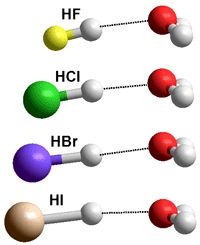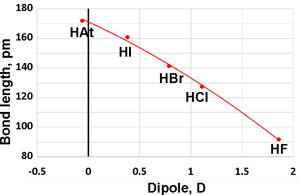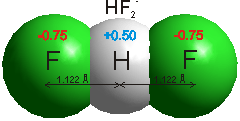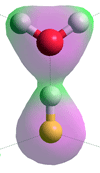
Qualitative comparison of gaseous
hydrated hydrogen halides

![]() Why is hydrofluoric acid a weak acid?
Why is hydrofluoric acid a weak acid?
'The energy of stabilization of covalent bonds by partial ionic character is accordingly so great for the bonds between hydrogen and the most electronegative atoms, fluorine and oxygen, as to overcome the anion-forming tendency of these atoms and to cause hydrogen fluoride and water to be much weaker acids than the hydrogen compounds of their heavier congeners.'
Linus Pauling, 1956, [3886b]
Melting and boiling points

The hydrohalic acids (HF, HCl, HBr, and HI) are the simplest of acids and are extremely soluble in water. The three heaviest (HCl, HBr, and HI) are strong acids, practically completely dissociating in aqueous solution. The pKas in dilute aqueous solution are +3.17 [3887], -7, -9, and -9.5 for HF, HCl, HBr, and HI [3885] respectively 3888b. b Recent recalculation of the pKas in infinitely dilute solution at 25 °C has given values of -7.3, -9.8 and -10.3 [3889]. Therefore, their free energy of dissociations (ΔG0=−RT ln Ka) are +18, −40, −54, and −57 kJ ˣ mol-1 respectively. The H-halide bond lengths in the gaseous monohydrates are calculated to be 0.92, 1.27, 1.41 and 1.61 Å respectively (see top right).
Bond lengths and dipole moments

When anhydrous they form low-boiling liquids (see above right). The molar polarizabilities are 2.0, 7.1, 9.1, and 13.5 for HF, HCl, HBr, and HI respectively [3888c].
In aqueous solution, HCl, HBr, and HI dissociate:
HCl + H2O(aq) ![]() H3O+(aq) + Cl-(aq)
H3O+(aq) + Cl-(aq)
HBr+ H2O(aq) ![]() H3O+(aq) + Br-(aq)
H3O+(aq) + Br-(aq)
HI + H2O(aq) ![]() H3O+(aq) + I-(aq)
H3O+(aq) + I-(aq)
The halide ions hydrogen bond to water molecules only very weakly and prefer to sit in partially puckered clathrate cages (see elsewhere for a description).
Variation of the Hammett constant with HF concentration
[3890]
![Variation of the Hammett constant with HF concentration, [3890] Variation of the Hammett constant with HF concentration, [3890]](images/pkahf.gif)
In contrast to HCl, HBr, and HI, in dilute solution, HF behaves like a weak acid. The question often asked is, 'why?' [3886]. any reasons have been put forward for this, but mostly these are different views of the same phenomenon.
Fluorine is the most electronegative of all the elements (F = 3.98 cf., O = 3.44; Cl = 3.16; Br = 2.96; I = 2.66; ) and the bond between it and hydrogen is very polar. The hydrogen atom carries quite a lot of positive charge (~+0.5) balanced by the fluorine that is fairly negatively charged (~-0.5).
The acidity of aqueous HF increases with concentration, as shown right where the Hammett acidity constant (H0)a is used rather than the pKa [3890]. The graph may be less than quantitative due to possible contaminants. H2SO4 shows similar behavior. The rationale for the increase in acidity is that as the water content decreases the hydration of the H3O+ decrease (lower water activity) and the positive charge is less spread out so increasing its acidity. At higher HF concentrations (very little water) the solution is effectively HF and the following reactions occur:

2HF ![]() [H2F2]
[H2F2] ![]() H2F+ + F-
H2F+ + F-
2 [H2F2] ![]() H3F2+ + HF2-
H3F2+ + HF2-
where H2F+, H3F2+ etc. are more acidic than H3O+. Although anhydrous HF does not conduct an electric current, concentrated HF has a high ionic conductivity due to processes similar to the Grotthuss mechanism:
F-···H-F···H-F ···H-F ![]() F-H···F-H···F-H···F-
F-H···F-H···F-H···F-
H+···F-H···F-H ···F-H ![]() H-F···H-F ···H-F···H+
H-F···H-F ···H-F···H+
It appears that HF ionizes fairly completely in solution in water, but instead of producing free hydroxonium ions, H3O+, and fluoride ions F-, there is such a strong attraction between these that they form a strongly bound hydrogen-bonded ion pair, [H3O+.F-]. As the H3O+ ion is not free, it does not act as an acid. Other reactions that occur are:
[H3O+.F-] + HF ![]() H3O+ + HF2-
H3O+ + HF2-
2H20 + F- ![]() [H3O+.F-] + OH- with metal fluorides
[H3O+.F-] + OH- with metal fluorides
Using thermodynamics, another way of looking at the pKa of dilute aqueous HF is that there is a very large negative entropy of hydration (greater order) of F- with TΔS0 =−31, −17, −10, and −2 kJ ˣ mol-1 (at 25 °C) for HF, HC1, HBr, and HI, respectively [3888a]. This indicates a strong binding of water molecules to the fluoride ion, its kosmotropic activity, whereas the bigger chaotropic halide anions Cl-, Br-, and I- yield positive hydration entropy. Also, the fact that the weak acid HF dissociates more at a lower temperatures reflects this large negative entropic contribution,
Structure of hydrated HF molecule calculated
using the Restricted Hartree-Fock wave function (RHF)
using the6-31G** basis set, see also [3892]
![Structure of hydrated HF moleculecalculated using the Restricted Hartree-Fock wave function (RHF) using the6-31G** basis set, see also [3892]](images/hfh2o9.gif)
 The structure of the close ion-pair [H3O+.F-] has not been found using ab initio calculations (see right) with the undissociated hydrogen fluoride being more stable than the dissociated case at least up to hexa-hydration, using density functional theory and Møller–Plesset second-order perturbation methods [3895]. Using the Restricted Hartree-Fock wave
function (RHF) with the 6-31G** basis set, the F-H, H···O and F···O distances are 0.968 Å , 1.43 Å and 2.4 Å respectively, with the charges on the F, H and O atoms being -0.486, +0.499 and -0.816 respectively (see left). The three next nearest O-atoms (water molecule) to the F-atom are 2.9 Å away and the next two O-atoms (water molecule) 4.2 Å away. This has separately been shown that mostly one water molecule is bound to the H atom of hydrogen fluoride, whereas frequent exchanges occur at the F-atom (with weaker H-bonds), and that a coordination number of (5 + 1) is the most preferred one for the first hydration shell [3891]. Under deuterated conditions using ab initio molecular dynamics at low concentration, DF was found to form a strongly bound complex, dynamically fluctuating between F-D···D2O and F-···D3O+ structures [3893].
The structure of the close ion-pair [H3O+.F-] has not been found using ab initio calculations (see right) with the undissociated hydrogen fluoride being more stable than the dissociated case at least up to hexa-hydration, using density functional theory and Møller–Plesset second-order perturbation methods [3895]. Using the Restricted Hartree-Fock wave
function (RHF) with the 6-31G** basis set, the F-H, H···O and F···O distances are 0.968 Å , 1.43 Å and 2.4 Å respectively, with the charges on the F, H and O atoms being -0.486, +0.499 and -0.816 respectively (see left). The three next nearest O-atoms (water molecule) to the F-atom are 2.9 Å away and the next two O-atoms (water molecule) 4.2 Å away. This has separately been shown that mostly one water molecule is bound to the H atom of hydrogen fluoride, whereas frequent exchanges occur at the F-atom (with weaker H-bonds), and that a coordination number of (5 + 1) is the most preferred one for the first hydration shell [3891]. Under deuterated conditions using ab initio molecular dynamics at low concentration, DF was found to form a strongly bound complex, dynamically fluctuating between F-D···D2O and F-···D3O+ structures [3893].
[Back to Top ![]() ]
]
a The Hammett acidity function H0 determines the acidity of any solution by the fraction of a series of neutral indicators which are converted from an uncharged molecule to a protonated species.
H0 = pKa+ log (neutral indicator/positively charged indicator)
H0 approaches pH in dilute aqueous solution but deviate at high concentrations. The following indicator series has been used; 2,3-dinitroaniline, pKa - 2.46; 2,3-dinitroaniline pKa - 3.67; 4-methyl-2,6-dinitroaniline, pKa- 4.44; 6-bromo-2,4-dinitroaniline, pKa- 6.71; anthraquinone, pKa- 8.27; 2,4,6-trinitroaniline, pKa- 9.41. Different indicators give slightly different curves and their pKas may shift. [Back]
b These pKas for HCl, HBr and HI are very negative due to the effect of the very low activity of the water. [Back]
Home | Site Index | Solubility of non-polar gases | Hydrophobic hydration | Protein hydration | Nucleic acid hydration | Aqueous biphasic systems | Gas-liquid interface and nanobubbles | LSBU | Top
This page was established in 2020 and last updated by Martin Chaplin on 10 March, 2020